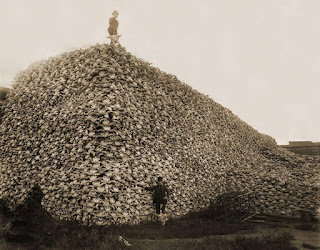The Return of the North American Bison: Restoring a Cultural Icon
Colin Glover
" They were so numerous they frequently
stopped boats in the rivers, threatened to overwhelm
travelers on the plains, and in later years derailed
locomotives and cars, until railway engineers learned by
experience the wisdom of stopping their trains whenever
there were buffaloes crossing the track…."
While hunting North American Bison (Bison bison) was a feature in the computer game,
"Oregon Trail", herds of them derailing trains weren't one of the dangerous encounters that could hinder your journey. But according to William T. Hornaday, a conservationist and zoologist in the early 1900's, these sort of obstacles were all too common. He also writes on the origin of the plains of bison,"The Indians of some tribes believed that the buffaloes issued from the earth continually, and that the supply was necessarily inexhaustible." (VI)
"Oregon Trail", herds of them derailing trains weren't one of the dangerous encounters that could hinder your journey. But according to William T. Hornaday, a conservationist and zoologist in the early 1900's, these sort of obstacles were all too common. He also writes on the origin of the plains of bison,"The Indians of some tribes believed that the buffaloes issued from the earth continually, and that the supply was necessarily inexhaustible." (VI)
But the next line of his "The Extermination of the North American Bison", written in 1889, is a little haunting.
"And yet, in four short years the southern
herd was almost totally annihilated…."
 |
| A Mound of Bison Skulls |
Over hunting was the killer of the expansive herds that roamed the plains, meadows, mountains and woodlands, as frontier men and women expanded west. Now, free roaming, wild bison inhabit around 1.2% of their original range, and their numbers, while stable, are maintained solely due to conservation efforts. These 1000+ pound beasts that once ruled over this land, are now dependent on human management, who put them in this dire circumstance just over 200 years ago(I)(IV).
And not only were the bison population and range decimated, but a way of life of other groups seemed to being going down with them. For many Native American tribes, bison served an important economic and cultural role. Their meat, hides, sinew, bones and more were used to feed, clothe and house the members of many tribes like the Assiniboine and Sioux. Horns and hides were also used for ceremonial garbs and artifacts(II)(III)(V)(VI). Now, many Native American tribes and reservations are stepping up to conserve and restore the bison population.
Today, with only 4 viable wild, free and semi-free roaming herds (which have greater than 1000 individuals) and an estimated total of around 12,000 individuals in these wild herds, this cultural icon is always at risk without management in such a fragmented landscape(I)(III). All of these herds inhabit Yellowstone National Park and are especially important as they serve as a source population for pure-bred, wild bison, which means that they do not contain the 1-2% of cattle DNA that most domestic bison have. Bison that wander outside of the Yellowstone are commonly targets of culling by farmers who fear transmission of the disease, brucellosis, to their domestic cattle(V). Reintroducing pure-bred bison to tribal lands, and eventually public land, offers economic benefits to the peoples that live on the reservations, and provide an insurance to extinction if something were to happen to the population in Yellowstone(III).
There are multiple treaties and partnerships in which conservation organizations like the National Wildlife Federation (NWF), Native American tribes, and reservations cooperate to help the bison population for decades(I). In 1997, the NWF and 40 Native American tribes of the Inter-Tribal Bison Cooperative (ITBC) pledged to host bison from Yellowstone(V). Again in 2012, The NWF partnered with the Fort Belknap and Fort Peck reservations to adopt American Bison from Yellowstone as well. The head of this program at Fort Belknap, Mike Fox, hopes to reach a population of 1,000 or more in the long term(III). The Northern Tribes Buffalo Treaty afforded 6.3 million acres of tribal land to be used for translocation(II).
This animal that made such an important contribution to the cultures of Native Americans and to the expanding frontiersmen came very close to extinction.But now this management dependent species can rely on the people that once depended on them for their livelihood.
Citations:
I) Aune, K., Jørgensen, D. & Gates, C. 2017. Bison bison. The IUCN Red List of Threatened Species 2017: e.T2815A45156541. http://dx.doi.org/10.2305/IUCN.UK.2017-3.RLTS.T2815A45156541.en. Downloaded on 01 May 2018.
II) Hofberg, Mark. “Tribes and First Nations Sign ‘Buffalo Treaty.’” THE WILDLIFE SOCIETY, 19 Oct. 2014, wildlife.org/tribes-and-first-nations-sign-buffalo-treaty/.
III) Nwf and Tribes Seek to Establish Genetically Pure Bison Herds." National Wildlife (World Edition), vol. 50, no. 1, Dec2011/Jan2012, p. 23.
IV) Shackleton, David M., and Alton S. Harestad. "Bovids I: Kudus, Buffaloes, and Bison (Bovinae)." Grzimek's Animal Life Encyclopedia, edited by Michael Hutchins, et al., 2nd ed., vol. 16: Mammals V, Gale, 2004, pp. 11-25. Gale Virtual Reference Library, http://link.galegroup.com/apps/doc/CX3406700962/GVRL?u=uno_eklong&sid=GVRL&xid=ce803467. Accessed 2 May 2018.
V) Van Putten, Mark. "Restoring an Important Part of America's Heritage." National Wildlife (World Edition), vol. 35, no. 3, Apr/May97, p. 19.
VI) Watt, Donald A. "THE MIDDLE YEARS: William T. Hornady: The Extermination of the American Bison." ["Defining Documents: Environment & Conservation (1791-2015)"]. Defining Documents: Environment & Conservation (1791-2015), 4/1/2016, pp. 57-60.


No comments:
Post a Comment